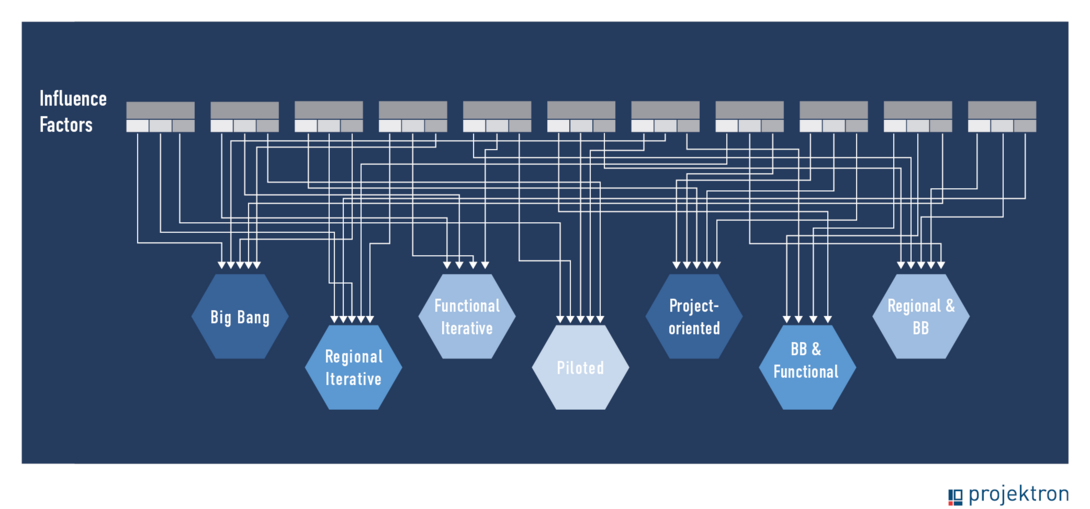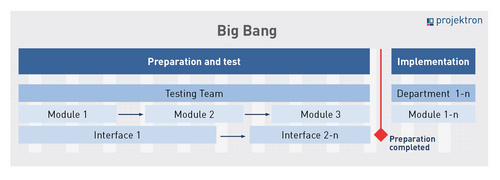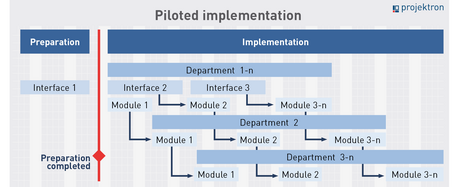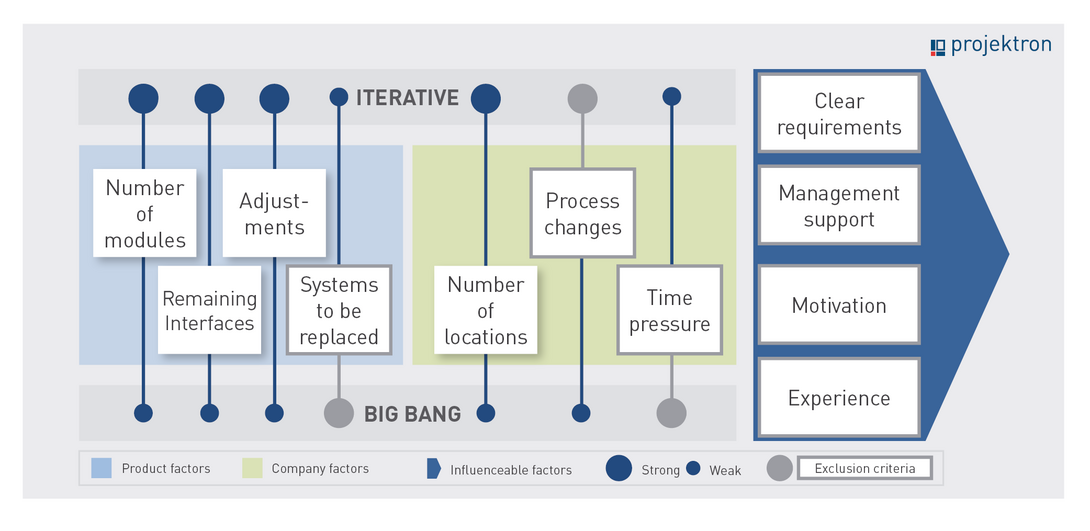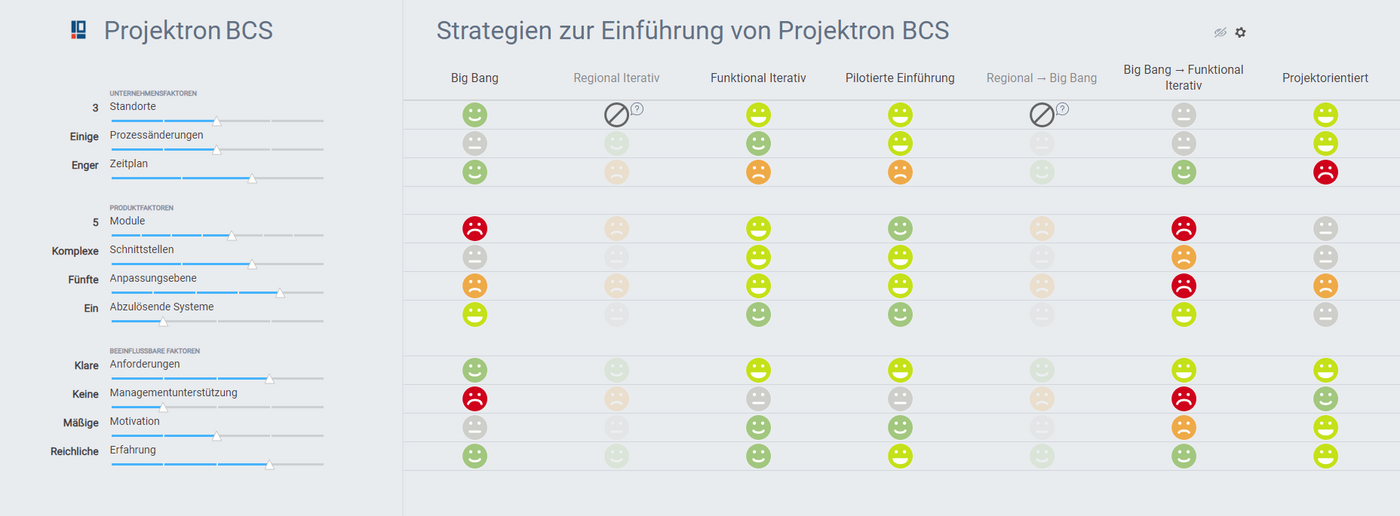03/27/2023 - Articles
Software implementation: step by step or big bang?
The implementation of enterprise software is a complex undertaking. It requires reliable project management and specific know-how. What rollout strategies are there? Which strategy is suitable for which situation and for which purpose? Which factors influence which strategy is the right one? With this knowledge, you can lead your implementation project to success.
What is a software rollout?
The term "software introduction" (also "software rollout") describes the process of establishing new software in an organization. It is often equated with more technical tasks such as software distribution, installation and configuration. However, the term actually encompasses the entire process of introducing new software (such as an ERP system, project management software, or other enterprise software) into an organization.
This process includes
- Requirements definition
- Software selection
- Software implementation and integration
- Monitoring of the new software during operation (operation and maintenance)
- Training of users in the use of the software
The goal is to ensure that the software can be used effectively and meets the company's requirements. The selection of suitable software can already be regarded as a separate project, which is followed by the actual software introduction as a further project.
The purpose of a software implementation is to successfully implement a new or updated software in order to improve business results, increase efficiency and productivity, and meet the needs of the company.
Why software implementation is important
The introduction of new business software is always a delicate matter - both for those involved in the customer company (project management, decision-makers, management) and for the provider, usually represented by the software company's user consultants.
On the one hand, such a project ties up resources, and on the other hand, the introduction has important consequences with regard to business processes. When a new project infrastructure is introduced in project-driven companies, it affects the competitiveness of the company. Possible mistakes during the software introduction should therefore be known in any case and avoided through professional project management.
- The larger the customer company is
- the more locations and departments are to be equipped with the software and
- the more deeply the software product is to be integrated into the corporate structures and business processes...
...the more complex and strategically significant it is to choose the optimal software implementation strategy.
Phases of software implementation
A software implementation project, just like any other project, can be divided into five project management phases.
- Initialization
- Definition
- Planning
- Control
- Completion
According to this IPMA model, which is based on five project management phases, the rough project structure is determined in the definition phase. In the software implementation project, this is based on the implementation strategy, which means that this must also be determined in the definition phase, i.e. before project planning.
According to the IPMA definition, the project structure, resources, deadlines and costs are planned in detail in the planning phase, the overall project plan is defined and project risks and countermeasures are determined in an iterative process. If the risks are too great, it is possible to revert to the definition phase and change the implementation strategy.
The concrete activities in the project are described in project phases. In a software implementation project, there are different project phases depending on the implementation strategy selected: For example, in the same project, the implementation of the first module may be in the final phase, while the implementation of another module is still in the planning phase.
Software implementation: strategies
The choice of rollout strategy comes up in the definition phase of any software rollout project. Essentially, three different types of rollout strategies are used:
- Big Bang Approach
- Iterative rollout strategies
- Combined rollout strategies
In practice, the three basic approaches are often combined to form complex rollout strategies. The decision as to which rollout strategy is the most suitable in a particular case depends on a large number of influencing factors and the specific advantages and disadvantages of the various rollout strategies.
Fast and complete with a big bang: big bang software launch
With the big bang strategy, all software modules are activated for all users on a specific date. The new software replaces the old system holistically, so that users do not have to maintain processes in the new and old systems in parallel and only work with the new software from the launch date. Big Bang is the fastest and most cost-effective way of introducing software for large companies, because there is no need to pay for, maintain and interface multiple applications in parallel - provided everything goes according to plan.
If problems occur, a big-bang rollout quickly incurs high costs. In the worst case, if the implementation project is aborted and fails, there can be no "rollback" to the legacy system and all business processes come to a standstill. The abrupt change to a new solution can be too much for many employees - acceptance problems are imminent. In the worst case, the new software is not accepted and the intended goal is not achieved.
Software implementation with Big Bang only makes sense if
- the management is fully behind the introduction of the software and supports the process,
- the employees have a positive attitude towards the introduction
- the goals and requirements are known
- an experienced project manager is available.
Is the Big Bang method right for your launch project?
You can find out more about introducing software according to the big bang approach, advantages and disadvantages, as well as tips on how to proceed in the article "Introducing software according to the big bang model: Fast with a big bang".
Best practice big bang introduction: items GmbH & Co. KG
Discover the success story of items GmbH & Co. KG and their seamless transition to Projektron BCS! Find out how this full-service IT service provider in the energy industry implemented Projektron BCS back in 2011 after Big Bang, increased efficiency and is ready for future growth. Read the full case study now for inspiring insights and valuable learnings!
Step by step: iterative implementation strategies
Iterative, i.e. step-by-step, strategies for software introduction mitigate the high risk that exists in the Big Bang. If the stakeholders identify a problem in the course of the implementation project, it can be remedied with comparatively little effort. Even if unfixable problems occur, the price of failure is lower: The implementation depth was lower and a return to the legacy system is still possible.
The higher level of certainty comes at the expense of effort: an iterative rollout takes more time than a big-bang rollout because it takes place in multiple phases. Each individual phase of the implementation project is less complex in itself than a big bang implementation. The duration of the entire implementation project increases with the number of phases.
Centrally controlled companies must be prepared for a lower quality of central controlling during an iterative introduction project. This is especially true if the company introduces the new software on a site, department and project-oriented basis. The customer company has two options: Either it provides many temporary interfaces in this case, or it maintains the data in the old and new systems in parallel. Both extend the project duration and result in higher costs.
Purely iterative implementation strategies can be subdivided into:
Project oriented implementation
In the first implementation step, the software is used by a motivated project team (test team) for one project. After adaptations, the extension to every team and every project takes place company-wide. You can find out more about the project-oriented approach, advantages, disadvantages and tips in the article "Project-oriented software introduction: Adaptation according to experience".
Functional iterative introduction
The modules of a modular software solution are introduced one after the other. You can find out more about the introduction of software according to the functional iterative approach, advantages and disadvantages as well as tips on how to proceed in the article "Functional iterative software introduction: Module by module to success".
Regional/departmental iterative rollout
The software is introduced step by step across sites or departments. You can find out more about introducing software using the regional and departmental iterative approach, advantages and disadvantages, and tips on how to proceed in the article "Regional or departmental iterative software introduction".
Combined implementation strategies
While the variants big bang, functional/regional iterative and piloted can be described as clearly definable, other strategies or combinations of these strategies are also used in practice for large implementation projects of complex enterprise software. They can be adapted more precisely and individually to the needs of the company.
Different implementation strategies can be combined in any way. Three possible combinations:
|
|
|
Especially for software rollouts of many modules and at many sites, even more complex combinations may be the best concept. For example, for a rollout of eight modules at eight sites, the first four modules could be rolled out regionally iteratively at two sites, followed by Big Bang for the remaining six sites. For the next four modules, a functionally iterative rollout for all eight sites might be the optimal choice.
Is a combined strategy suitable for your implementation project?
Find out and learn about the combined strategies with their respective advantages and disadvantages. You can find a detailed description of the combined implementation strategies in the article "Combined implementation strategies: A combo for successful software implementation".
11 factors influencing the choice of strategy for software implementation
Based on practical experience, Projektron GmbH's user consultants have identified eleven central framework conditions that determine which strategy is the most suitable for a company. These eleven factors can be divided into:
- Three given company factors
- Four company factors that can be influenced
- Four product factors
Given company factors
Three corporate factors can only be actively influenced by project managers of the software provider and the company to a very limited extent.
|
|
|
Product factors
The architecture and characteristics of the software itself influence strategy selection in the form of four factors.
|
|
|
|
Influenceable business factors
Four factors are given, but are largely influenceable. The software vendor's consultant and the company's internal project manager should try to actively influence them before and during the project in the interest of a successful implementation.
|
|
|
|
Improve the chances of success for your implementation project
In the article "Implementing software: These 11 Influencing Factors Determine Strategy" you will learn more about the individual influencing factors and about ways in which you can influence them in your favor.
How the characteristics of the factors determine the choice of strategy
The diagram below shows the influence of the various factors on the choice of either iterative strategies or the big bang approach. The product factors highlighted in light blue speak more strongly for iterative approaches as the number of modules, adaptations or interfaces to be set up increases. However, if the number of systems to be replaced is very high and many interfaces therefore have to be set up temporarily from the old to the new system, this is a knockout criterion and leads to big bang implementation.
Among the business factors that cannot be influenced (highlighted in green), time pressure is an exclusion criterion against iterative approaches. Many process changes speak against a big bang introduction. The more sites and users there are, the more likely an iterative approach is the better choice.
The decisive factor for choosing the right strategy is usually the business factors that can be influenced. Each of these four factors, which are highlighted in blue, can be improved with appropriate measures, so that further strategies can be considered. The tendency toward either an iterative or big bang approach thus results in a large number of concrete implementation strategies.
You still don't know which strategy would be the best for your individual case? No problem! We have decades of accumulated experience in the implementation of complex enterprise software and can support your project team individually, specifically and competently through strategy development, training, workshops and in a consulting capacity.
Strategy development with expert tool
Weighing up the eleven complex factors and recommending the appropriate implementation strategy is a demanding task. We user consultants at Projektron GmbH use an expert tool for the introduction of Projektron BCS, which we developed specifically for this purpose.
The consultants fill in the input fields of the tool in workshops and in dialog with the customer company by determining appropriate values for the eleven influencing factors. The tool
- weights the criteria according to the conditions and requirements of the respective client company,
- visualizes the suitability of the strategies in a comparative manner and
- gives concrete recommendations for action in order to prepare the introduction in the best possible way and to optimize the conditions before the start of the project.
There are often several strategies that come into question under the given framework conditions. Managers (client company) and consultants (provider of the software) should focus primarily on the four company factors that can be influenced. Those who have the opportunity to positively influence these factors for the implementation project automatically have more freedom in the choice of strategy.
Expert tool for strategy finding: advantages for customers and consultants
The expert tool helps consultants,
| objectively select the best possible implementation strategy for the customer's requirements, | |
| initiate targeted measures to optimize the influencing factors for the application of the respective strategy. |
The tool offers customers
| maximum transparency: it makes the consultant's recommendation comprehensible and creates acceptance for the measures among the workforce. | |
| the possibility for self-determination: it empowers the customer to make the selection for the desired implementation strategy himself. |
Conclusion: Software introduction needs expertise
Once you have successfully completed your selection project for a new enterprise software and an initial test, you can initiate the software introduction project. In the definition phase of the implementation project, the choice of the appropriate implementation strategy is the central factor that determines the success or failure of the software implementation. Therefore, make it the focus of attention. It decides on the entire concept of the software introduction, on time schedules, on concrete measures from migration of the data to the contents of a training for the employees.
When deciding on a strategy, you must evaluate the complex interaction of various influencing factors and recognize combinations of characteristics that exclude or make certain strategies mandatory.
This task is very complex and can only be decided internally within the company with a great deal of experience. If you are introducing new enterprise software, you should enlist the help of specialists and manage the introduction project together with the software provider's user consultants on a basis of trust.

About the author
Francisco Josué Artaza has been working with Projektron GmbH for 15 years, currently as marketing manager and user consultant. He is certified according to IPMA, PRINCE2 as well as Scrum Product Owner. He is an expert in software implementation strategies and has developed a tool that facilitates the selection of the appropriate strategy.
More interesting articles in the Projektron blog
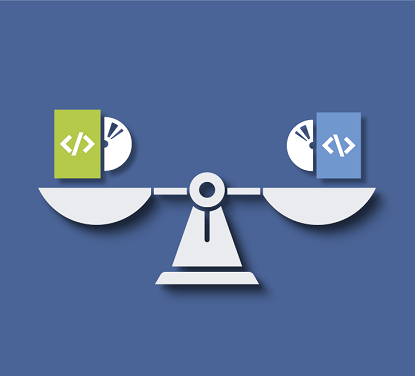
Project management software comparison 2024
Get an up-to-date overview: We compare 13 of the most popular and best project management software solutions. Start here, discover the market and compare for yourself!

7 advantages of PM software
From better Excel spreadsheets to comprehensive business coordination software: what advantages does project management software offer and for whom is it worth buying a PM tool? We provide 7 good reasons why your company will benefit from project management software.

Choosing PM software
If your SME or company is about to choose project management software, you probably don't know where to start looking for the right PM tool for you. This guide will guide you through the PM software market and lead you to the right decision in 9 steps.

Project communication
One of the main reasons for project failure is a lack of project communication - according to a PMI study, project communication management is just as important as accurate cost estimation, a clear definition of project objectives and a thorough risk analysis. 3 practical tips for your project communication!
